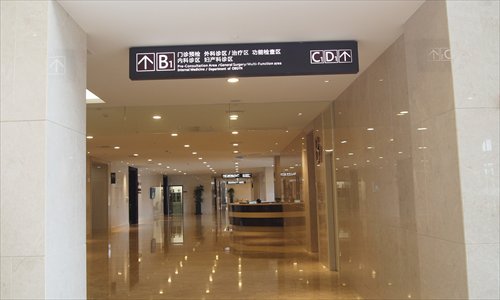

The interior of the newly opened Shanghai International Medical Center. Photo: Ni Dandan/GT
When 6-year-old Chen Chen (pseudonym) became the first child patient at Shanghai's newly-opened medical center, her mother paid 800 yuan ($128) for the registration fee alone. It was a fortune compared with the normal charge of 14 yuan at the city's public hospitals, but although this fee is comparatively high, some patients are charged even more to register, reaching up to a maximum of 1,200 yuan.
Amid discussions over the high registration fees and the diversion of top doctor resources from public hospitals, the Shanghai International Medical Center (SIMC) has been conducting a trial run for the last two months.
Potentially a pioneer in medical reform, it is among a new breed of private hospitals that is charging patients more, while also utilizing public resources, raising a number of questions over whether the fees are justified.
But with its main shareholder being a State-owned enterprise, it is achieving things other hospitals can't.
"One thing is that we are providing a platform for public hospital doctors to carry out services at multiple locations, which is what the city health department has been working to promote. The other is that since the authorities have been keen to reduce and eventually withdraw all the paid "luxury" VIP services from public hospitals, there are hopes our center will take on the patients from these sectors," Zhang Chengyu, director of the SIMC, told the Global Times.
Medical oasis
Without the long lines, the hassle and the quarrels that plague most hospitals, the new medical center, in a remote location in Shanghai's Pudong New Area, is much more tranquil and is built like a luxury hotel.
Brightened by a few crystal chandeliers, the hall of the outpatient building has a few sofas where some men in suits sit and talk. In the center is the registration desk, behind which the center's staff - all dressed in black uniforms - wait for patients. To the right is a cafe where doctors often chat while enjoying a cup of tea.
To visit a doctor here, one needs to make an appointment. For the first month of the center's trial operation, it saw nearly 100 patients, which Zhang said was beyond his expectations given the fact that many departments aren't expected to open until around the end of this month.
According to the director, government guidance and market demands are behind the foundation of the new center. Despite the fact that medical reform has brought tangible benefits to the general public, Zhang said all parties, including government departments, medical staff and the public, are disappointed. He pointed out that a single type of medical service can never satisfy everybody's needs.
"Just like when it comes to transport, we have accommodation trains, bullet trains, high-speed trains, ships and planes. Travelers can take into account their time requirements and cost when making a choice."
Zhang Chengyu told the Global Times that based on his knowledge, many of the city's expats have long been dissatisfied with city's medical services. "They cannot adapt to the environment at public hospitals while the private ones sometimes don't provide the services they require given the limitations imposed by their smaller scale.
"That's why the city government needs a hospital like ours," Zhang said. The center, covering some 70,000 square meters, has 500 beds, 118 outpatient consultation rooms and 15 operation rooms.
But it's not a facility exclusive to the high-end class, according to the director. "The center also targets medium-level office workers who can afford to purchase commercial medical insurance," he said.
At present, the medical bills at the center are paid for in full by the patients. Commercial insurance will be introduced into the center in June, Zhang said. "For the first phase, we will provide services covered by 10 major insurance companies, which occupy around 50 percent of the local market."
Moonlighting doctors
In contrast to most hospitals in China, full-time doctors at the SIMC account for less than half of the total number on staff. The rest come from Shanghai's top public hospitals - doctors who practice at multiple locations. Around 70 such doctors will regularly come to check on their appointed patients at the SIMC from next month onward, Zhang told the Global Times.
The practice, according to Huang Yiran, deputy director of Renji Hospital, a highest-rated public hospital in Shanghai, is essentially aimed at balancing medical resources to better serve the public. "Unlike Western countries where the training systems for doctors are quite complete and therefore there is no major difference in terms of professional skills among doctors, Chinese doctors from different regions and hospitals differ a lot in this aspect. Thus, encouraging the city's best doctors to carry out medical practices in other facilities both in Shanghai and elsewhere in the Yangtze River Delta is conductive to the overall improvement of medical services in the region. It also means that patients don't need to pour into big hospitals for some common diseases," Huang told the Global Times.
Huang said that such practices had unofficially been occurring for a while and the city health department was now standardizing them with the SIMC acting as a prototype facility. A specialist in urology himself, Huang became the first public hospital doctor to see a patient at SIMC on April 14. "I think it is a good thing. We are not doing this for money but for the need to reform."
Premier Li urges deepening medical reform
2014-04-05Govt to increase funding for medical reform
2013-03-15Medical reform in crucial stage
2013-02-27Copyright ©1999-2018
Chinanews.com. All rights reserved.
Reproduction in whole or in part without permission is prohibited.